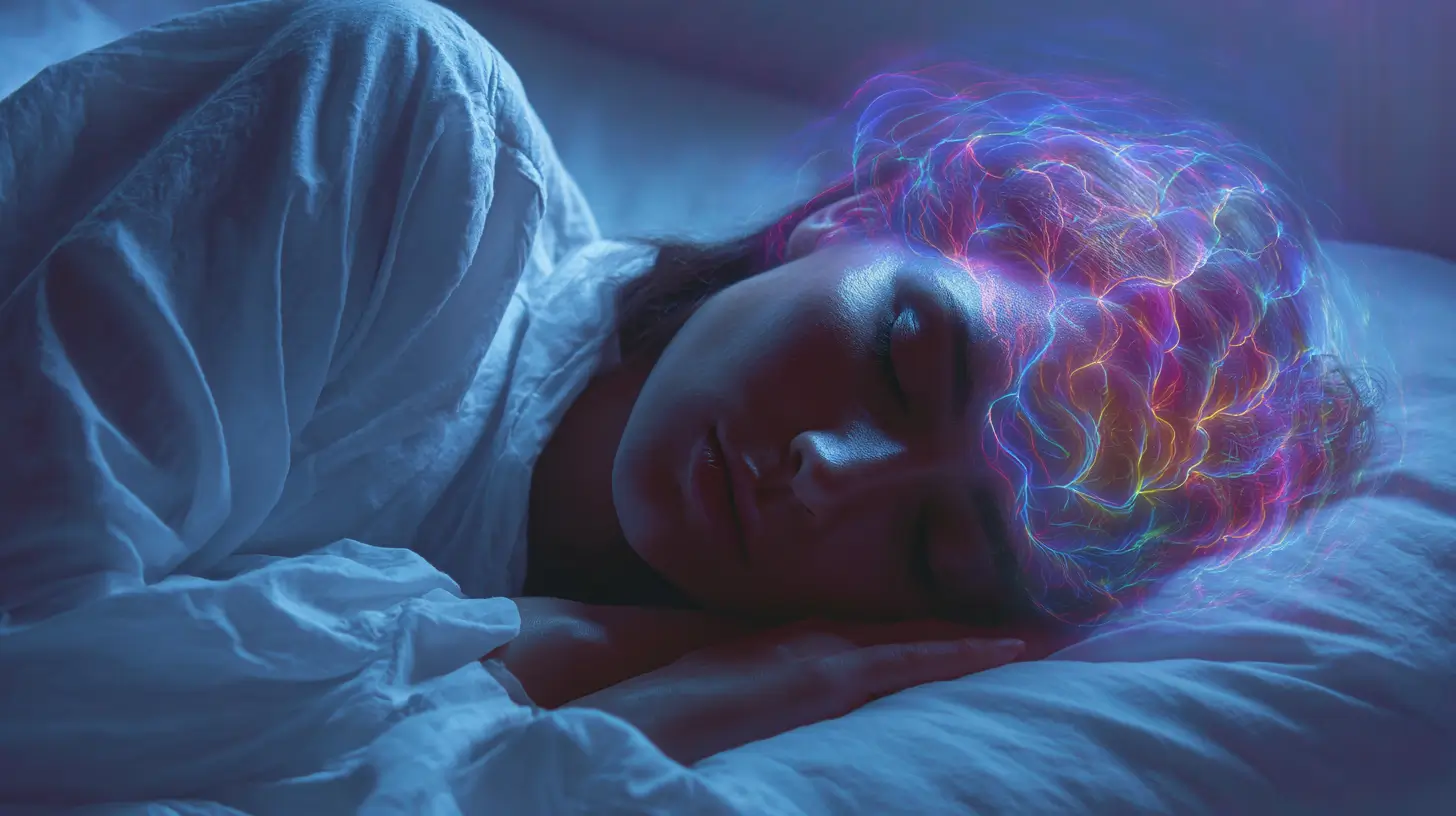“The mind is everything. What you think you become.” — Buddha.
This guide explains how measurable brain waves—especially those in the 8–12 Hz band—support calm confidence and how targeted sleep routines can reinforce that pattern.
EEG measures electrical activity on the scalp and shows when the mind shifts from busy to relaxed. Research and classic work by Joe Kamiya link these rhythms to learning relaxation with feedback.
Practical promise: by shaping pre-sleep scripts and routines, you can nudge daytime composure and reduce noisy self-talk. Readers will find clear steps, science-backed context, and immediate actions they can try tonight.
Key Takeaways
- The 8–12 Hz rhythm supports wakeful relaxation and steady confidence.
- EEG offers objective measures that show how neural activity shifts with practice.
- Pre-sleep programming can reinforce calm beliefs while the mind transitions to sleep.
- Practical routines in this guide let you train reliable composure for the day.
- The article separates solid research from promising ideas so you can move forward wisely.
Why the Alpha Brain State Matters for Confidence and Sleep Programming
Quiet, regular oscillations in waking neural activity mark moments when attention can turn inward. In that soft rhythm, internal chatter fades and self-talk becomes easier to shape.
What this means for confidence: the rhythm reflects a wakeful, relaxed mode that supports focused internal attention. That makes it ideal for rehearsing calm imagery and positive affirmations before bed.
Research links increased alpha activity with lower anxiety and improved creativity. Neurofeedback studies show anxiety drops when people learn to raise this rhythm. A randomized 2015 study also found creativity gains after enhancement.

“Enhancing these rhythms can create practical shifts in mood and mental flexibility.”
- Entering this rhythm before sleep makes programming easier and more durable.
- Meditation and mindfulness reliably raise posterior alpha, offering an accessible on-ramp.
- Brief, repeated priming sessions compound into measurable changes over time.
Bottom line: aligning pre-sleep routines with this relaxed pattern helps synchronize body and mind, lower stress chemistry, and give you a practical edge in building steady confidence.
Alpha Brain State Explained: From Electrical Activity to Measurable Brain Waves
Scalp electrodes convert synchronized neuron firing into clear, measurable rhythms that reveal how the mind organizes itself.
EEG records tiny voltage shifts produced when many neurons fire together. These summed signals appear as rhythmic brain waves and are described by frequency — cycles per second measured in hertz.

How frequency and electrical activity form waves
Frequency tells you how fast a rhythm repeats: alpha runs at 8–12 Hz, theta at 4–8 Hz, and beta at 12–35 Hz. Delta is very slow (0.5–4 Hz) while gamma can reach 32–100 Hz.
Where this pattern sits among other types
Alpha sits between slower theta and faster beta rhythms. Each type of wave reflects dominant network dynamics, not a single mental function.
Occipital dominance and eye closure effects
Alpha is strongest over the occipital cortex and rises with eyes closed. Visual input — or even imagined scenes — suppresses alpha amplitude, which helps explain why resting the eyes calms internal chatter.
- Neurons fire in coordinated patterns and make detectable scalp voltages.
- Consistent regional distribution matters more than a single cycle.
- Understanding these basics helps interpret consumer EEG feedback wisely.
Alpha vs. Beta, Theta, Gamma, Delta: What Each Brain Wave Signals About Your Mind
Distinct rhythmic bands in EEG map to recognizable mental modes and everyday tasks. Understanding these types helps you choose practices that shift your focus or calm your nerves.
Alpha waves (8–12 Hz) support wakeful relaxation and inward attention. They rise with eye closure and meditation, making them useful before sleep or performance warm-ups.
Beta (≈12–35 Hz) corresponds to alert focus and active engagement. Beta waves help execution and problem solving, but prolonged beta activity can feel tense without recovery.
Theta (4–8 Hz) appears as the mind drifts toward sleep or deep relaxation. Theta waves signal early sleep stages and meditative depth—good for creative incubation and unwinding.
Delta waves (0.5–4 Hz) mark deep, restorative sleep. These slow, high-amplitude rhythms power physical recovery and memory consolidation.
Gamma (32–100 Hz) links to rapid integration and complex perception. Gamma waves reflect high-level processing rather than relaxation targets.
- Practical guide: invite alpha to settle, use beta to execute, rely on theta to ease into sleep.
- Remember: each band is a descriptive category — multiple waves interact to shape moment-to-moment cognition.
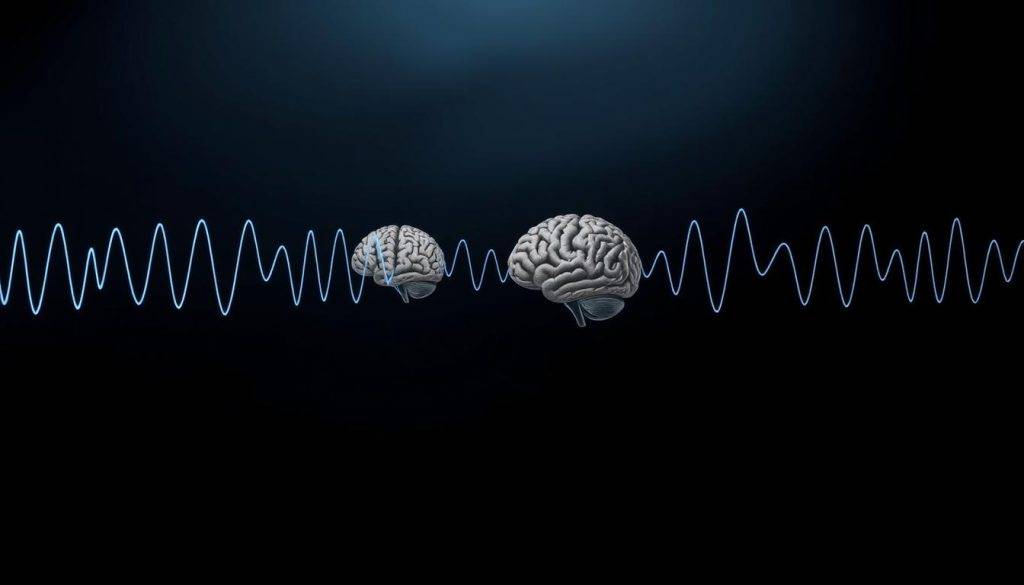
“Frequency distinctions give you tools to design routines that move the mind where it needs to be.”
Alpha Waves and Sleep: NREM stages, alpha intrusion, and the window for programming
As sleep begins, the brain often shows a brief period of relaxed rhythms before slower activity takes over. This moment—Stage 1 of NREM—is when waking rhythms appear then give way to theta waves. It is a natural handoff that marks high suggestibility for gentle programming.
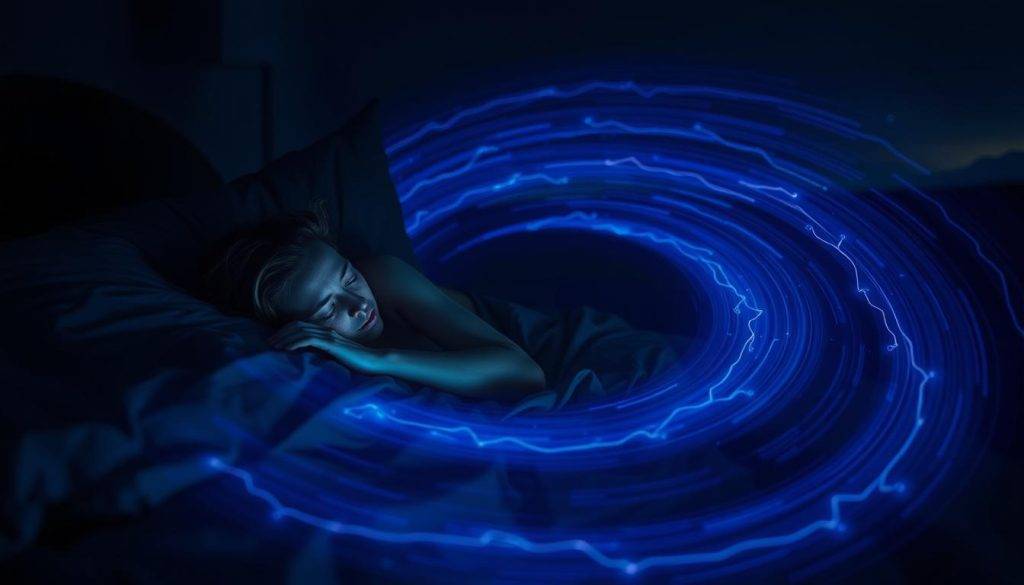
Stage 1 transitions
In Stage 1, short bursts of alpha activity are common at first. Then theta rises and those faster patterns fade. That shift creates a practical window: calming scripts or soft imagery timed to coincide with fading alpha waves may stick better.
Alpha intrusion and effects on sleep
Sometimes alpha reappears later in NREM—called intrusion. When that happens, people often report nonrestorative sleep and daytime tiredness. An EEG can confirm whether transitions are typical or disrupted.
| Feature | Typical Stage 1 | Alpha Intrusion |
|---|---|---|
| Dominant waves | Alpha → Theta | Alpha persists into NREM |
| Sleep quality | Progressive deepening | Shallow, fragmented sleep |
| Common symptoms | Fresh on waking | Nonrestorative sleep, daytime fatigue |
| How to respond | Time programming early | Discuss with clinician; consider EEG |
Practical tip: encourage relaxed activity and lights-down to support the natural alpha-to-theta handoff, then let the brain progress toward delta waves for true restoration.
“Timing and environment matter—use the Stage 1 window, but avoid forcing rhythms later in NREM.”
Evidence-Based Benefits and Limits of Alpha Brain Waves
Clinical work combines EEG, neurofeedback, and stimulation to test how rhythmic shifts change mood and cognition. Several controlled studies show clear gains, but limits matter.
Neurofeedback that nudges relaxed rhythms has reduced anxiety in people with generalized anxiety disorder, though many protocols mixed theta and alpha. tACS trials that boosted targeted rhythms reported lower depression symptoms in major depressive disorder samples.
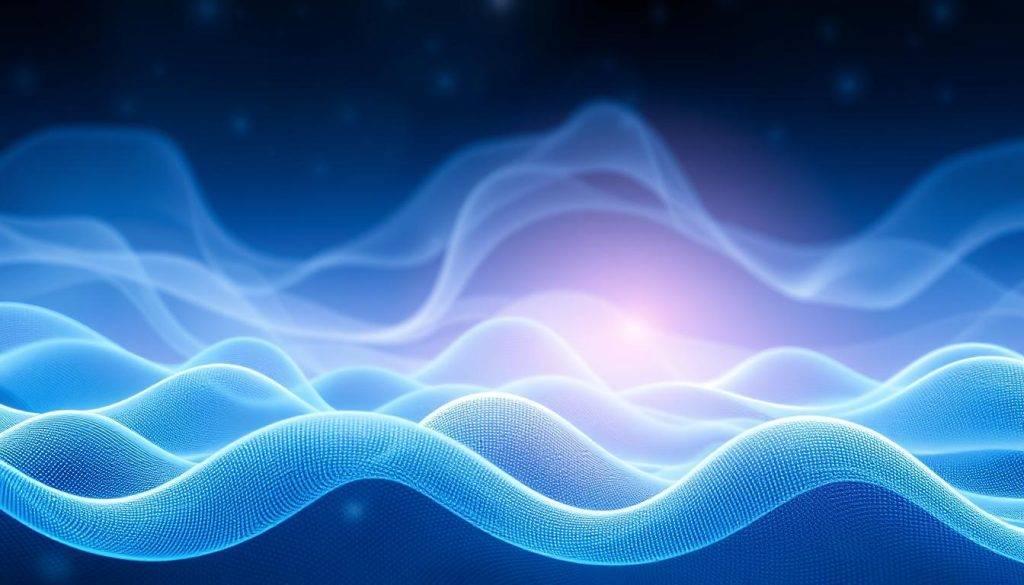
What the research finds
- Multiple studies link increased alpha with reduced anxiety and a greater sense of calm.
- tACS normalization of rhythms has shown symptom drops in depression, suggesting promise but not a cure-all.
- A 2015 randomized trial found enhancing alpha raised scores on the Torrance test, supporting boosts in creativity.
- Raised alpha also helps gate distractions, improving selective attention in task settings.
“Alpha is a lever—powerful when combined with solid routines and realistic expectations.”
Bottom line: EEG-backed mindfulness or quality neurofeedback can move these waves and produce meaningful effects. Expect variation across people and types of intervention, and pair tools with steady practice for best results.
Training the Alpha Brain State: Meditation, Mindfulness, and Sleep Programming Routines
Short evening practices help people tilt toward calm patterns before bed. Regular training makes relaxed rhythms easier to access and keeps daytime confidence steady.

Breath-led meditation and simple mindfulness
Use slow, nasal breathing with a soft eye focus or closed eyes for five to ten minutes. This practice helps increase alpha and resets tension quickly.
Body scanning and open monitoring quiet imagery and internal chatter. Those mindfulness cues reliably raise posterior alpha activity in many people.
Pre-sleep wind-down: music, light, timing
Create a 45–60 minute routine: dim lights, stop screens, and pick calm instrumental music. This window eases the brain toward sleep and supports relaxation.
Designing a sleep programming script
Write a short script with serene imagery and present-tense affirmations. Play it as you first lie down to catch Stage 1 when alpha gives way to theta.
Self-guided neurofeedback principles
- Notice deeper breaths, muscle release, and fewer intrusive thoughts as markers of rising calm.
- Practice at the same time each day to entrain the rhythm.
- Combine brief journaling with sessions to track progress and refine what works.
“Small, consistent habits—simple breath, gentle focus, and timed scripts—create measurable gains in relaxation and readiness.”
Tech and Neurofeedback: Modern EEG Tools, Safety, and Smart Use
Modern wearable EEG tools put multi-channel monitoring into everyday hands, changing how people learn from their own signals.
Where early monitors used one or two electrodes, today’s devices often use six or more sensors and smarter processing. That shift improves detection of real electrical activity and reduces false readings from muscle or movement.
Why it matters: better electrodes, region comparisons, and advanced algorithms let neurofeedback target meaningful features rather than a single band.
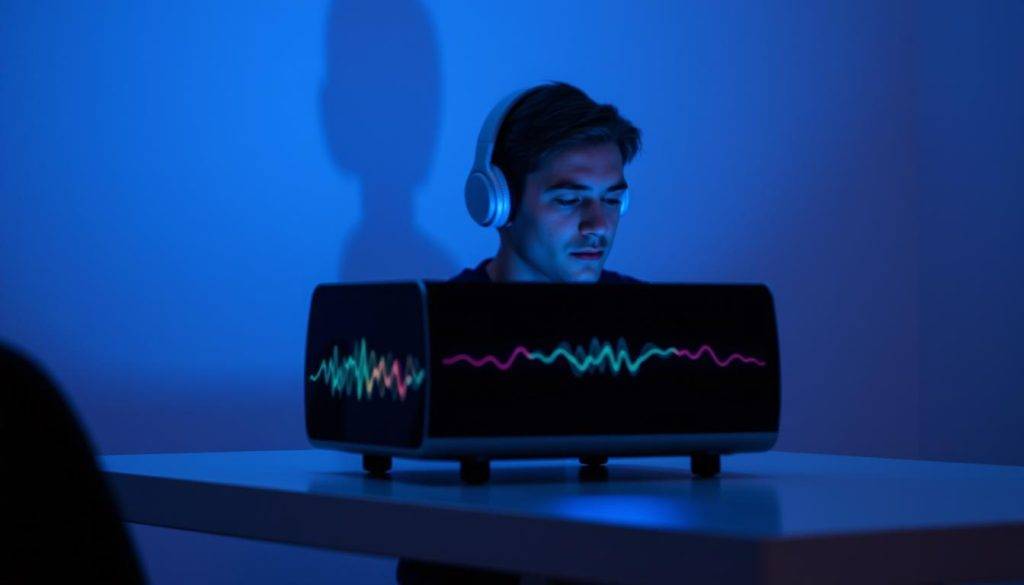
From single-channel units to multi-electrode wearables
Early units gave a useful signal but lacked spatial context. Newer wearables map multiple sites to show patterns across regions.
This matters when protocols train more complex features — for example, comparing posterior and frontal activity rather than flagging one dominant wave.
Signal quality, algorithms, and consumer education
Algorithms now clean artifacts, compare regions, and provide richer feedback. Still, quality varies across brands.
- Look for transparent signal metrics and published validation.
- Check fit, electrode contact, and artifact rejection to avoid misleading data.
- Pair device use with proven habits—breathwork, light control, and short meditations—to amplify gains.
“Neurofeedback is promising when used with clear protocols and realistic expectations.”
| Feature | Early Monitors | Modern Wearables | Consumer Considerations |
|---|---|---|---|
| Electrodes | 1–2 | 6+ | Check placement and contact quality |
| Algorithms | Simple band thresholds | Multi-region, artifact rejection | Demand validation and transparency |
| Training targets | Single-band feedback | Composite features across waves | Expect multi-feature protocols, not magic fixes |
| Safety | Low risk; limited guidance | Guided protocols; dose control | Avoid overtraining; monitor fatigue |
Practical advice: choose devices with clear EEG metrics, start simple, and monitor how you feel. Neurofeedback can shift patterns, but the best results come from education, realistic goals, and steady practice.
From Lab to Culture: How Alpha’s Reputation Was Built
Scientific findings and popular storytelling combined to shape how people think about relaxed wave patterns. Early lab work gave this rhythm a clear, measurable identity, and public interest turned it into a symbol of calm.
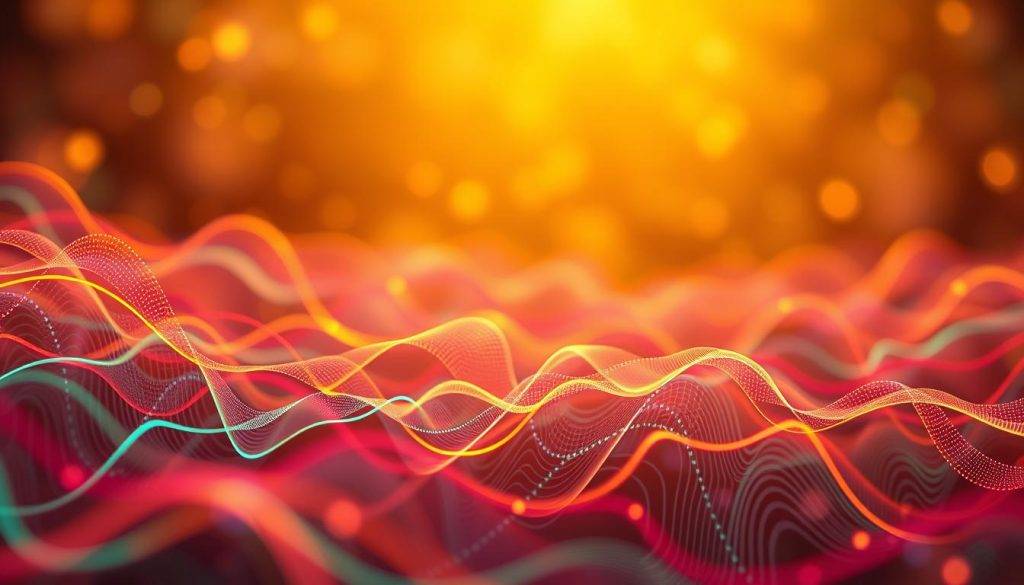
Hans Berger to Joe Kamiya: milestones that shaped meaning
Hans Berger first recorded human EEG and named the dominant rhythms now known as alpha and beta. His recordings made it possible to treat electrical activity in the scalp as meaningful data.
Adrian and Matthews localized the pattern to the occipital region and showed it rose with eye closure—an insight that informed meditation and pre-sleep practice.
In the late 1960s and 1970s, Joe Kamiya taught people to notice and sustain the rhythm through feedback. His work bridged lab study and lived experience and helped launch early consumer monitors.
- 1970s devices and media framed the rhythm as a path to serenity.
- Cultural enthusiasm sometimes simplified complex research into catchy claims.
- Modern science treats the rhythm as one useful tool among many—valuable, but not a magic fix.
“Use history as a guide: let evidence inform your practice, and treat tools as aids—not guarantees.”
Conclusion
Timing simple practices with the brain’s shift toward sleep makes mental habits stick more easily.
Use the calm window before sleep to anchor short, breath-led meditation and a concise wind-down script. These steps help increase alpha waves and support relaxed attention that carries into the day.
Evidence links higher alpha activity to lower anxiety, better creativity, and improved focus. Structured training, smart devices, and gentle stimulation show promise for mood symptoms—but they work best paired with steady practice and realistic expectations.
Track morning refreshment and tweak routines if sleep feels shallow. With consistent training and clear intent, these simple habits reshape neurons and build reliable confidence for work and life.
FAQ
What is the alpha brain state and how does it relate to confidence and sleep programming?
The alpha brain state refers to rhythmic electrical activity in the 8–12 Hz range that appears during relaxed wakefulness. It supports calm internal attention and can create a receptive window for gentle suggestion or sleep-focused routines. When used with intentional pre-sleep practices—breath work, calm imagery, or timed scripts—this relaxed rhythm can help lower anxiety and make confidence-focused messages easier to absorb before sleep.
How do EEG measurements show alpha activity and where does it sit among other brain waves?
EEG records voltage changes produced by neurons. Alpha shows as regular 8–12 Hz oscillations, often strongest over occipital regions when the eyes are closed. It sits between slower theta and delta rhythms (linked to sleep) and faster beta and gamma rhythms (linked to focused attention and information processing).
Can increasing alpha activity improve relaxation and reduce anxiety?
Research in neurofeedback and mindfulness indicates that boosting alpha can promote relaxation and reduce physiological signs of stress for many people. Techniques like breath-led meditation and gentle visualizations reliably increase alpha power, which correlates with lower anxiety in short-term studies. Results vary across individuals and protocols.
Does alpha intrusion during sleep harm sleep quality or daytime functioning?
Excessive alpha during NREM sleep—often called alpha intrusion—can fragment sleep and reduce restorative slow-wave activity. That may leave people feeling unrefreshed or more fatigued during the day. If sleep feels fragmented despite good sleep habits, medical evaluation or a sleep study can clarify causes.
How does alpha compare to beta, theta, gamma, and delta in everyday mental work?
Each frequency supports different brain modes: beta supports alert, goal-directed focus; gamma relates to complex information processing and binding; theta links to drowsiness, memory consolidation, and light sleep; delta dominates deep restorative sleep. Alpha sits between focused alertness and sleep, supporting relaxed internal attention and creative incubation.
Are there proven clinical benefits for depression from manipulating alpha rhythms?
Noninvasive stimulation methods like transcranial alternating current stimulation (tACS) that target alpha frequencies have produced mixed results in depression research. Some trials report symptom improvement for subsets of patients, while others show limited effects. Alpha-targeted interventions may help when combined with established treatments, but they are not a universal cure.
What practical practices increase alpha without devices?
Simple, device-free methods reliably raise alpha: slow diaphragmatic breathing, eyes-closed rest, guided imagery, and mindful body scans. Consistent short sessions—10–20 minutes daily—support sustained changes. Pre-sleep wind-down routines that dim lights and reduce stimulation also help prime relaxed rhythms before bed.
How can sleep programming scripts be timed to match sleep-stage transitions?
The best window for gentle programming is during sleep onset, when alpha gives way to theta (Stage 1). A calm script should begin during relaxed eyes-closed wakefulness and continue into light sleep, using low-volume, simple phrases, pauses, and non-arousing imagery. Timing and volume are crucial to avoid awakening the listener.
What should someone know about consumer EEG wearables and neurofeedback tools?
Modern wearables range from single-electrode headbands to multi-sensor systems with better spatial resolution. Signal quality, artifact rejection, and algorithm transparency vary widely. Users should prioritize validated devices, clear instructions, and realistic claims—neurofeedback trains patterns over time but is not an instant fix.
Can alpha enhancement boost creativity and attention control?
Increasing relaxed alpha can support creative idea generation by reducing top-down filtering, allowing broader associative thinking. It can also help shift attention inward for reflection. For tasks that require sustained alert focus, balanced engagement of beta rhythms remains important—one frequency does not replace others.
Is it safe to use audio or electrical stimulation to change brain rhythms at home?
Low-intensity audio entrainment and guided recordings are generally safe for most healthy adults. Electrical stimulation (tACS/tDCS) should be approached cautiously—use only clinically validated devices under professional guidance. People with epilepsy, active neurological conditions, or implanted medical devices should consult a clinician before experimenting.
How quickly do people notice benefits from alpha-focused routines or neurofeedback?
Subjective relaxation often appears after a few sessions of breath work or meditation. Sustained shifts in resting rhythms or improved sleep typically require weeks of consistent practice or multiple neurofeedback sessions. Individual factors—baseline stress, sleep hygiene, and lifestyle—affect the timeline.
Who were the key figures in building the scientific reputation of alpha rhythms?
Early EEG pioneers like Hans Berger documented rhythmic brain activity, and researchers such as Joe Kamiya advanced experiments linking subjective states to recorded rhythms. Subsequent studies integrated neurofeedback, cognitive neuroscience, and clinical trials to refine understanding of how rhythmic activity relates to cognition and sleep.
























































